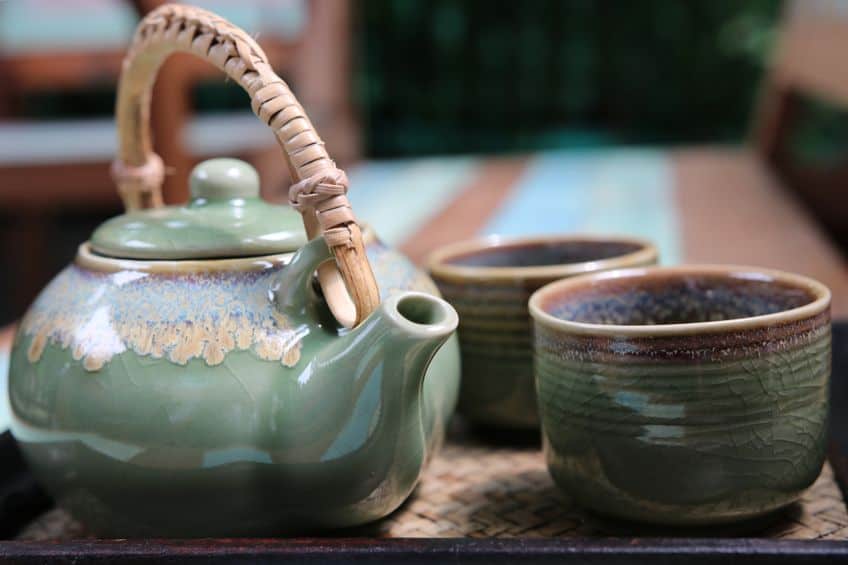What Is Raku Pottery? – Explore the Raku Ceramic Techniques
Even if you are an avid pottery artist or maker, you might not have heard about Raku pottery. There are many types of pottery as well as different techniques used to create items. Different cultures also have unique ways of creating pottery. Raku ceramic items originate from a traditional Japanese technique. In this article, we will be discussing a few Raku techniques and how to go about the Raku pottery process. You are certain to learn something new!
What Is Raku Pottery?
Traditional Raku firing is a Japanese method for creating a unique type of bowl. The technique has been used for many years in Japan and has a close relationship with the Japanese tea ceremony. Raku techniques involve taking glazed ceramics from a kiln while it is still very hot.
The ceramic item is then placed in a substance or material that is combustible, for example, sawdust or paper. The glazed ware is forced to cool down quickly, where the surface oxygen is depleted. The method produces an intense reaction that can result in a combination of colors that appear within the glaze. This can also be done without a glaze, which then creates more of a black or matte color. The intense heat and change in temperature also produce cracking in the surface, which is called “crackling” and is done on purpose.

The Roku process crafts an item by hand and does not require a potter’s wheel. The Raku pottery process creates a unique clay item, as you do not have control and you never know what the results will be. The traditional Raku firing uses all-natural elements. Earth to make the item, fire in the kiln, and cooled in air or placed in cold water to cool the process down.
Raku firing uses a low-fire process and is done differently in Western and Japanese cultures. In Western Raku, which is usually made from stoneware clay is first bisque-fired at 1830 degrees Fahrenheit (900 degrees Celsius) and then glaze-fired at about 1830 degrees Fahrenheit (1000 degrees Celsius). Some may use electric kilns, but it is not recommended, a gas kiln might work better, or a designed Raku kiln.
The Japanese Raku fires at lower temperatures of about 900 to 1200 degrees Fahrenheit (500 – 650 degrees Celsius) in a kiln that is fueled with charcoal.
Brief History of Raku Pottery
The word Raku translates as “happiness in the accident”, which is exactly what happens. The pottery item is placed in the kiln and whatever comes out is a “happy accident”. Raku techniques originated in Japan, during the 16th century. The traditional Raku firing stems from Buddhist influences, particularly those that are connected to the tea ceremony. The ceramic Raku bowls were often found to be used in these tea ceremonies, and those who practiced the tradition preferred the simplicity of the ceramic items. The Raku tea bowls were founded by a well-known potter of the time, Tanaka Chōjirō (1516 – 1592).
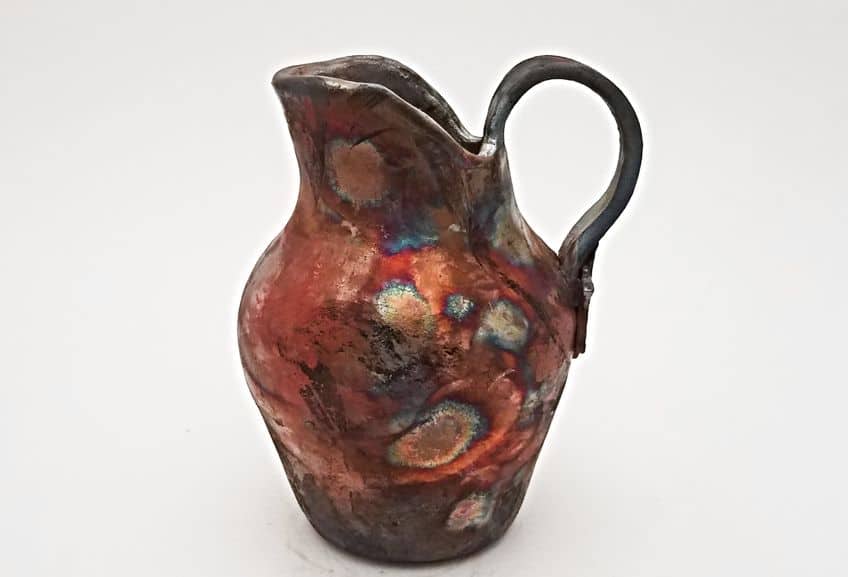
The traditional Raku firing was brought to the West by Bernard Leach (1887 – 1979) in the 1900s. Later, in the 1960s, Paul Soldner (1921 – 2011) spread the tradition more widely among Americans. There are a few things that differ between the Eastern and Western methods. Japanese Raku ceramics use mostly brown, red, or black glaze, which produces more natural tones. The method is also a cultural activity, mainly for the Japanese tea ceremony. Western forms use brighter colors, and it is more just an experimental form of ceramic firing.
Roku ceramics has also progressed over the years, the tea bowl remaining a traditional item, but now also producing all kinds of pottery, with different Raku looks.
Techniques and Processes of Making Raku Pottery
Raku firing is a process that is much faster than the normal methods used and takes one to two hours instead of an entire day. Normally, the temperature of the kiln is managed carefully, and the temperature is changed gradually. The rapid cooling of pottery can cause it to crack. The Raku pottery process is fairly simple and begins with glazing your item. The glaze is specifically made to have a low melting point and only a thin layer is required to produce the desired effect. Let us look further into the Raku pottery process.
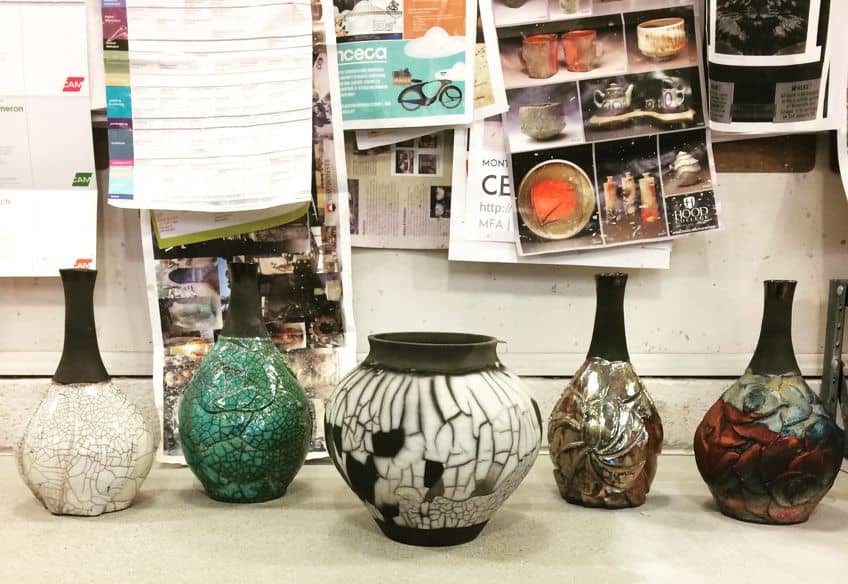
Raku Firing Technique
When using the traditional Raku firing method, the pottery item is placed in a cold kiln and then heated rapidly. The Raku firing cycle is short and can range from only 15 to 20 minutes, depending on the glaze and kiln used. The ceramic item is then removed with tongs and cooled rapidly in the air or soaked in water. Generally, the item is ready to be removed when the glaze has stopped bubbling and appears glassy and shiny.
Deciding when the glaze is ready, requires observation, or many use a pyrometer to help with making a decision.
When you remove the pottery item from the kiln, you should be careful to protect the item and yourself. In Western methods, there is a post-firing reduction, where you put the item into some combustible materials. Take note, this will create quite a bit of smoke. Some suggestions for these materials are as follows.
- Sawdust
- Paper
- Woodchips
- Pine needles
- Straw
- Nutshells
- Dry leaves

Other ideas include a technique from Eastern Europe, where a mixture of flour, water, and yeast is made three days before being used. After being bisque-fired, it is taken out and placed in the yeast mixture and then soaked in water. Also, in Western Raku, the pottery item is first bisque fired, which opens up the clay body and makes it more durable for the Raku firing. The Raku firing takes about 30 to 90 minutes.
Clay Shapes and Textures
Specific Raku clay is best to use as it has high thermal shock resistance and does not shrink. When using traditional Raku firing, stoneware is usually used as it is less porous and more durable than earthenware or porcelain. You can use any type of clay as well, preferably ones with a high grog content. Grog is a type of grainy material that is added to the pottery to provide certain added properties, such as improving thermal shock resistance, helping to reduce shrinkage as well as cracks, and it also adds texture.
The traditional tea bowls were created by using what is known as the tezukune technique.
This is where the ball of clay is flattened into a thick disc shape, and the edges are then shaped into a bowl with the palms of the hand. Once the clay has dried a little, the clay is trimmed and then covered in glaze. The result is a simple shape, a straight-sided bowl shape that is not too wide, with a narrow base. Today, a Raku ceramic piece can be any shape, however, you should consider the immense temperature changes and the pressure this puts on the clay. So, items that are evenly created and on the thin side tend to endure. Some of the shapes to consider that can withstand the process include some of the following.
- Curved shapes
- Round orb shapes
- Pots and vertical sculpture pieces
Open shapes like wide bowls tend to crack easily, the same with any item that has too fine details or an item that varies in thickness. A pottery item that is smooth and plain also looks best after it has been under Raku firing. Adding textures or fine details can inhibit a Raku finish.
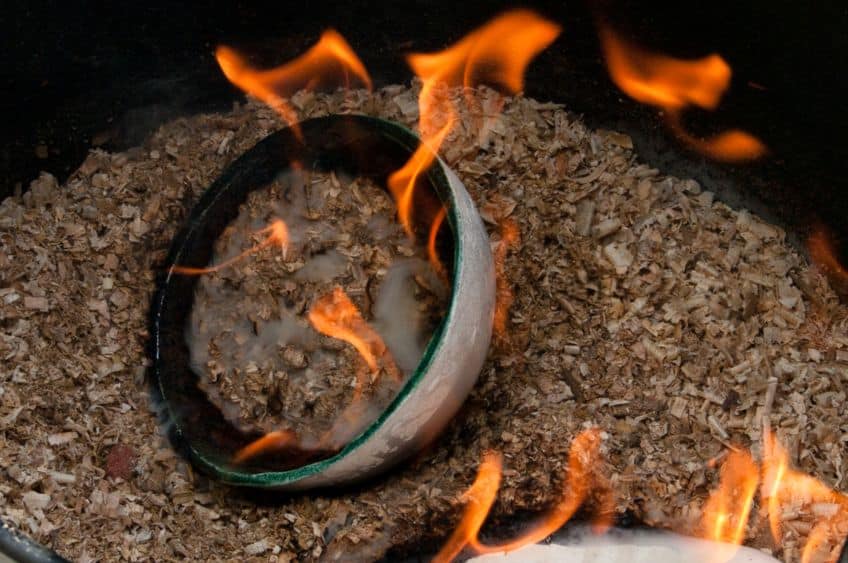
However, some potters do apply various techniques or textures. Horsehair Raku is one of the more unique ideas. These techniques take horse hair, or you can use human hair, feathers, or even dog hair, which is then draped over the hot ceramic item. This has a combustible effect that will leave a mark on the surface, which infuses into the pottery surface, creating unique designs. This technique is even better when the pottery item has been burnished, a method whereby the pottery item is polished to a sheen without using a glaze. Others apply terra sigillata, which is a super fine clay slip that provides a soft sheen before burnishing.
Bisque Glazing and Firing
Most low-fire glazes can work for this technique, or there are also glazes available specifically for Raku. You can use more than just glaze to create different effects. You can try oxides, stains, under and over glazes, slips, China paints, and underglaze pencils. All of these options will produce a unique look.
The outcome relies more on the Raku pottery process of firing. So, the glaze can be splashed on, sprayed, or dipped and will add a surprise effect.
Types of Kiln
There are different kilns available to apply the Raku pottery process. The main thing to consider is the rapid Raku firing cycle, which is a lot quicker than the usual firing methods. The kin needs to be able to reach the temperatures required. The traditional Raku firing uses coal or some other fuel-burning method. So, technically, an electric kiln is not the best option.
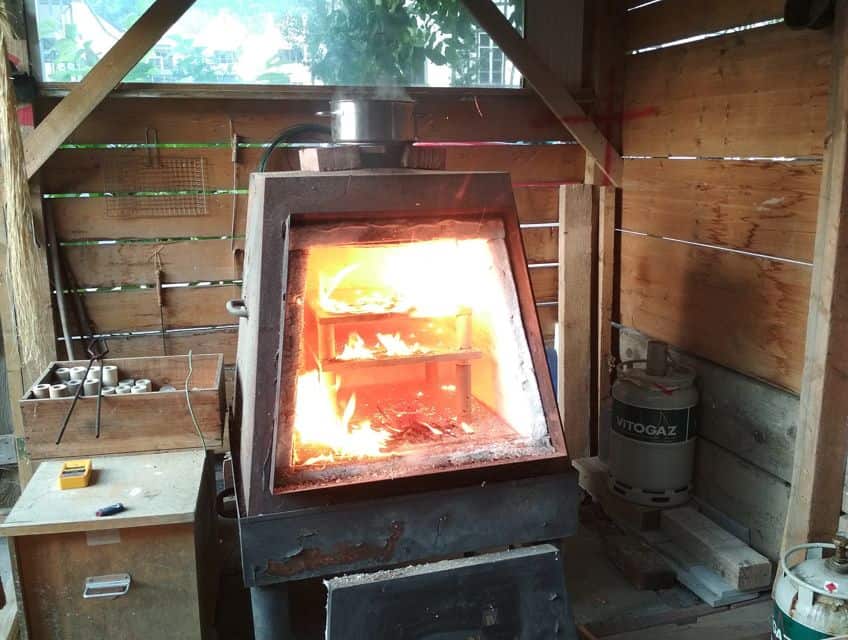
Since Raku firing is so fast, heating an electric kiln takes more time, and opening the door can prove damaging to the heating elements, because of the rapid lowering of temperature. However, some potters will still use an electric kiln. There is also a gas kiln option, however, there are commercial kilns that are specifically designed for using the Raku techniques. However, you can try building a type of kiln in a dustbin if you are that adventurous.
You should also consider the kiln size and how you are going to remove the pottery item from the kiln.
Larger kilns will produce huge amounts of heat when they are opened. So, for this purpose, a smaller kiln would work best. Also, a front-loading kiln is a better and safer option, as the heat from a top-loading kiln would be uncomfortable at best. It is also just easier to remove the pottery item from the front than the top.
Safety Precautions
Below are some ideas for providing safety when busy with Raku firing. It is best to be prepared and to make sure you are protected when dealing with such high temperatures. The Raku pottery process also produces a lot of smoke, depending on your reduction method. So, first, a respirator to filter out particles and fumes might be a good idea.
- Preferably, you should be using specially designed Raku metal tongs to remove the pottery.
- You can wear a face shield to help protect the face, or a combination respirator and face shield.
- Do not wear sandals or open shoes, rather opt for closed sneakers or boots.
- Wear clothes that are cotton-based, as synthetic materials are highly flammable.
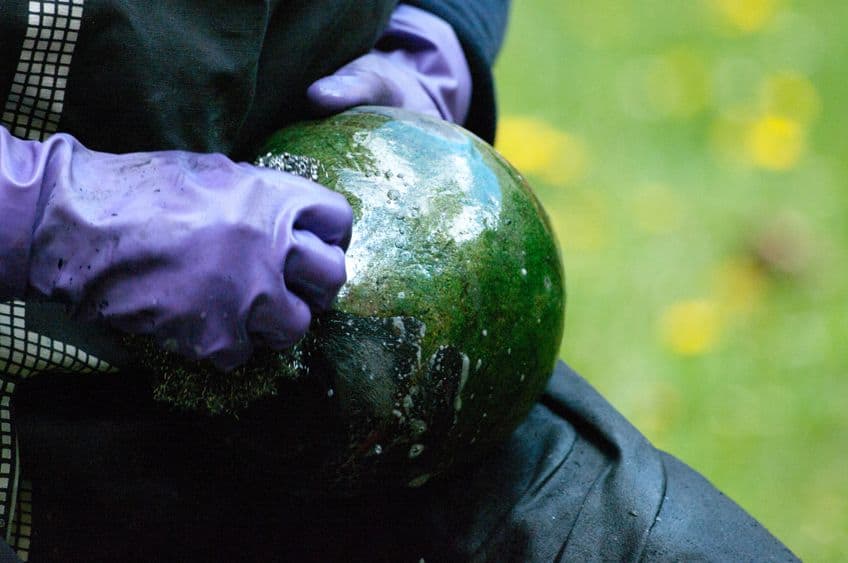
- You can wear long sleeves to help protect your arms.
- If possible, you can use a welding jacket.
- Protect your hands by wearing flame-resistant gloves.
- Always make sure you have a fire extinguisher close by.
Characteristics and Uses of Raku Pottery
A primary characteristic of Raku ceramics is the uniqueness of each item. This is because each piece is handcrafted, and the Raku pottery process is so unpredictable. Raku firing is done at low temperatures and is accomplished in a short time, so the ceramic material and glaze are not completely mature. The final clay item will be porous and can absorb liquids. This means it is also not durable and, sometimes, the glaze can flake off. So, a Raku pottery piece is not food safe or good for any functional use and is best left as a decorative piece. The Japanese use the Raku tea bowls in tea ceremonies.
However, even they do not leave liquids for long in the tea bowl, as it is fragile and porous.
Also, when removing the item from the kiln, there is a rapid temperature change, which can crack the surface and leave raised areas on the surface. Liquid can get into these cracks and bacteria, or mold can form. Some glazes also contain metal oxides, which can include cadmium and lead and are toxic, and can leach out of the pottery. Dinnerware also requires a lot of washing, which is not good for fragile Raku ceramics. This all makes it not appropriate for dinnerware.
Sealing Raku pottery is missing the point of the whole idea, but it can be done by using a Raku sealer that will help protect the glaze and clay and prevent the colors from fading. The sealer will also provide a slight sheen. You can also consider an acrylic spray sealer, or for slight protection wax and oil.
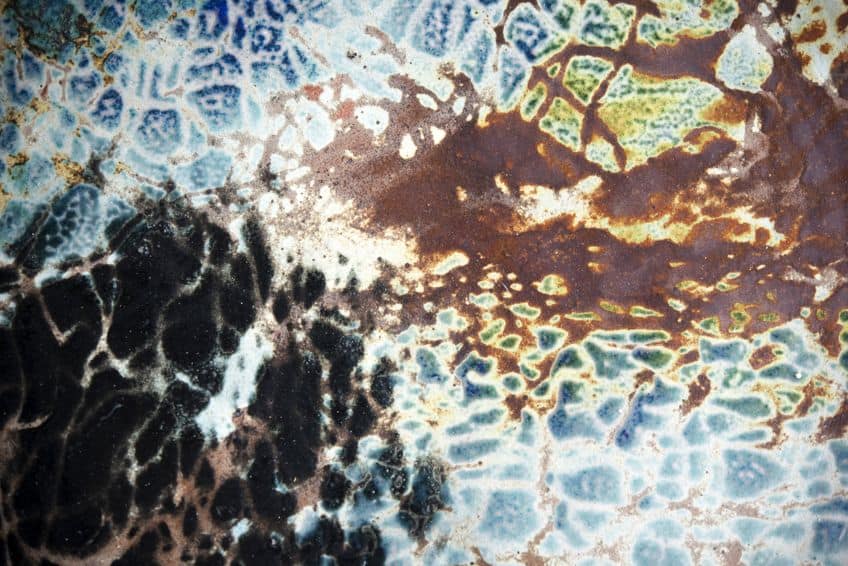
Some of the results of Raku firing can be seen as a crackled and glazed surface, or it could be an unglazed black surface. There are also amazing metallic effects you can achieve. Other textures can also be achieved, for example, as we have mentioned before, the Horsehair technique.
Famous Raku Artists
Raku pottery may have begun as a traditional Japanese technique, but it has now also become an interesting style that is done by some famous artists in the field of pottery. Let us take a look at a few names who have contributed to the art of Raku.
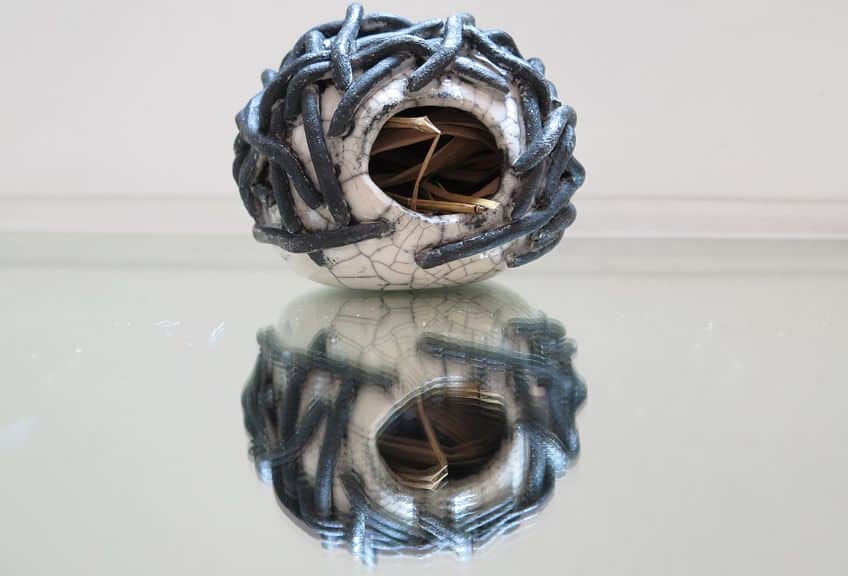
Tanaka Chōjirō (1516 – 1592)
| Date of Birth | 1516 |
| Date of Death | 1592 |
| Nationality | Japanese-Korean |
| Associated Art Movement | First generation Raku pottery master |
| Famous Examples of Work | Tea Bowl exhibit in the Tokyo National Museum, Tokyo, Japan |
Tanaka Chōjirō, a potter, became the first generation of Raku potters. At a certain time, he worked for an esteemed tea master by the name of Sen no Rikyū (1522 – 1591), who asked Tanaka to make some tea bowls. These bowls were then to be used in the Japanese tea ceremonies. This is what created interest in the bowls, which were considered things of beauty and refinement.
The methods he used produced either red earthenware or soft black glazed pottery that mostly reflected the ideals of wabi, a concept where the search is for simple things and finding the beauty in imperfection. For example, the unevenness of the ceramic bowl.
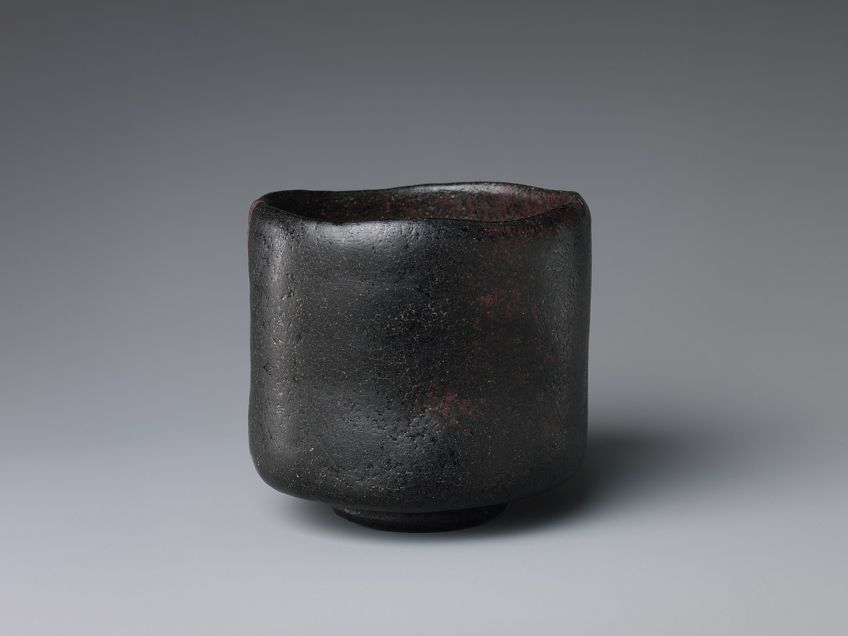
Over some time, the family adopted the name “Raku” and the tradition of making Raku ceramics continued in the family. Raku has become a great influence in Japanese culture and now is also used all over the world. The methods used today by the Raku family have stayed the same, where the black Raku bowls are fired individually, and the red bowls are done in batches of three to four.
Hon’ami Koetsu (1558 – 1637)
| Date of Birth | 1558 |
| Date of Death | 1637 |
| Nationality | Japanese |
| Associated Art Movement | Painter, calligrapher, and potter |
| Famous Examples of Work | Tea bowl (early 17th century), located at the Metropolitan Museum of Art, New York City, United States |
Hon’ami Koetsu was a Japanese craftsman that was trained as a sword polisher in the Japanese tradition. He was also a great potter, calligrapher, and lacquerer. His work is said to have encouraged the development of Rinpa, a historical school of painting. He is said to have had a great interest in the Japanese tea ceremony and was regarded as an excellent pupil of Furuta Oribe (1554 – 1615), a tea master and master of the Raku ware style.
Hon’ami Koetsu was considered a great artist, who incorporated his own style into the Raku tea bowls. One of his creations is known as Shiroraku-Chawan Fujisan, which is also considered a national treasure.

Chawan, meaning tea bowl, was named the single tea bowl that is associated with Mount Fuji and its snow-covered peaks. The appearance of the bowl is whitish on top and black. This tea bowl can be found in the Sanritsu Hattori Museum in Japan. Another tea bowl can be found in the collection of Asian art at The Metropolitan Museum of Art in New York City, United States of America.
Contemporary Raku Artists and Their Contributions
There are many Raku artists, who all have a passion for this style of ceramic art that has its origins in traditional Japanese techniques. Many contemporary artists have explored the technique and applied their own ideas.
Below are some artists who have made contributions to this art form over the years.
Paul Soldner (1921 – 2011)
| Date of Birth | 1921 |
| Date of Death | 2011 |
| Nationality | American |
| Associated Art Movement | Ceramic artist |
| Famous Examples of Work | Work pieces to view and for sale at artsy.net |
Paul Soldner is an American ceramic artist and was the first to experiment with the Japanese ceramic technique known as Raku. He manipulated and transformed the technique and started using his own methods, which became known as “American Raku” and “low-temperature salt firing”. His technique moved away from the traditional methods, but it still required depth and understanding to create. He is now known for his technique worldwide and is the founder of the Anderson Ranch Arts Center (1968).
David Roberts (Born 1947)
| Date of Birth | 1947 |
| Date of Death | N/A |
| Nationality | British |
| Associated Art Movement | Ceramic artist |
| Famous Examples of Work | Can be viewed on his website |
David Roberts is a well-known English potter, who has gained an international reputation for creating amazing Raku ceramics. He is also one of the leading ceramic artists who has introduced the contemporary Raku technique to Europe. He has also been vital in the re-introduction of the technique to the United States, especially the Naked Raku movement.
The pottery created uses a special type of method and is known by many names, including Naked Raku, Painting with Smoke, or Smoke Stencil Raku.
All pieces created have no glaze on the surface, it is “naked clay”, which is then stained by smoke patterns. His contemporary method is used to create his unique art pieces, which are often on display in public as well as private collections worldwide.
Well-Known Female Raku Contributors
There are also quite a few female Raku ceramicists, who have contributed to the contemporary Raku artists field. Each artist has a style of their own and their own impression of the Raku firing process. Patricia Shone, who lives and also works on the Isle of Skye uses the Raku technique. The landscape has inspired her work in ceramics, and she often uses a combination of techniques for a single piece, such as using low-temperature Raku firing.

Moyra Stewart graduated from the Edinburgh College of Art in 1979 and has worked in clay ever since. She specializes in handmade Naked Raku ceramics and many of her pieces have been displayed all over the world. Kate Schuricht, a well-known British ceramic artist, also uses Raku techniques. Her pieces are made in search of a sense of peace, using subtle colors and patterns for a more contemporary feel.
To gain an understanding of Raku ceramics, you need to delve into the appreciation of traditional Japanese Raku firing and techniques. Research further into the subject, and then experiment to discover how this remarkable technique develops and looks!
Frequently Asked Questions
What Is Raku Pottery?
Raku pottery is a traditional Japanese technique that uses a low-temperature Raku firing method to produce unique pottery items. The technique was first used for tea bowls, which were used in a traditional Japanese tea ceremony. Today, it has developed into a more contemporary art form that is used all around the world.
How Has the Raku Pottery Process Changed?
The main changes that have occurred are in the Raku pottery process, where traditionally the pottery was removed from a hot kiln and allowed to cool in the open air. Since it spread to other parts of the world, it is first bisque fired before being Raku fired and is cooled down by being plunged into water or various combustible materials.
Are Raku Ceramics Waterproof?
The Raku process is done at a low temperature and is completed quite quickly. This means that the clay and glaze have not developed thoroughly, leaving the clay porous and fragile. This means that it is not waterproof and is not food safe.
In 2005, Charlene completed her Wellness Diplomas in Therapeutic Aromatherapy and Reflexology from the International School of Reflexology and Meridian Therapy. She worked for a company offering corporate wellness programs for a couple of years, before opening up her own therapy practice. It was in 2015 that a friend, who was a digital marketer, asked her to join her company as a content creator, and this is where she found her excitement for writing.
Since joining the content writing world, she has gained a lot of experience over the years writing on a diverse selection of topics, from beauty, health, wellness, travel, and more. Due to various circumstances, she had to close her therapy practice and is now a full-time freelance writer. Being a creative person, she could not pass up the opportunity to contribute to the Art in Context team, where is was in her element, writing about a variety of art and craft topics. Contributing articles for over three years now, her knowledge in this area has grown, and she has gotten to explore her creativity and improve her research and writing skills.
Charlene Lewis has been working for artincontext.org since the relaunch in 2020. She is an experienced writer and mainly focuses on the topics of color theory, painting and drawing.
Learn more about Charlene Lewis and the Art in Context Team.
Cite this Article
Charlene, Lewis, “What Is Raku Pottery? – Explore the Raku Ceramic Techniques.” Art in Context. April 19, 2023. URL: https://artincontext.org/what-is-raku-pottery/
Lewis, C. (2023, 19 April). What Is Raku Pottery? – Explore the Raku Ceramic Techniques. Art in Context. https://artincontext.org/what-is-raku-pottery/
Lewis, Charlene. “What Is Raku Pottery? – Explore the Raku Ceramic Techniques.” Art in Context, April 19, 2023. https://artincontext.org/what-is-raku-pottery/.


